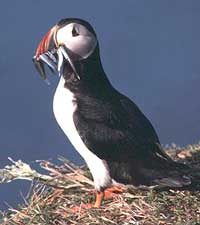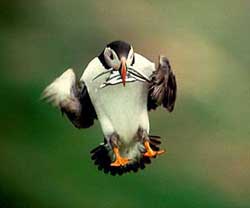Falling bird Fratercula arctica
The ancient retractable albatross has a scientific name, Fratercula arctica. This is one of the Atlantic seabirds that has many strange characteristics, which mainly live in the sea (except breeding season) and have a great adaptation to life there.
 Fratercula arctica is a good swimmer, and when they are deep in the water they wave their wings and push people away as if they are flying under water, using their feet to control the direction of swimming. Almost all year round regardless of weather conditions, they still fly, swim, dive or float on the waves. In the middle of the sea, seagulls draw their necks to eat fish and shellfish.
Fratercula arctica is a good swimmer, and when they are deep in the water they wave their wings and push people away as if they are flying under water, using their feet to control the direction of swimming. Almost all year round regardless of weather conditions, they still fly, swim, dive or float on the waves. In the middle of the sea, seagulls draw their necks to eat fish and shellfish.
Most of them go through the winter in the distance but there are also a few who go to winter. The season of breeding season, the seagulls pulled back from the water, flew to the ground to nest their eggs and hatched eggs. They often congregate to breed from April to August. These seabirds prefer to nest in soft areas that do not freeze on cliffs jutting into the sea or on the island. They like to use caves that were previously abandoned by rabbits or albatrosses, sometimes they also make small nests by using their feet to dig in the places between the rocks or in the grassy area. .
Fratercula arctica females usually only lay one egg (sometimes there are also 2 eggs), mainly hatching females, after 40-43 days of newly hatched eggs. Most seabirds feed their babies by feeding their burps with food from their stomachs, but their necks and nostrils often feed their children whole fish.
The most surprising thing is that they can catch a lot of fish in a single dive, and put the caught fish horizontally in the mine and fly to the nest to feed their children.
 In the past, it was thought that parents abandon young birds at the end of the breeding season to return to the sea to live. But the truth is, parents breed young birds until their children have enough wing feathers and can fly into the sea to live - often young birds start flying at night. Once you are out to sea, young birds will have to earn their living. They grew up when they were 45 years old, when they had a red ring around their eyes and covered the yellow flesh on the edge of the mine.
In the past, it was thought that parents abandon young birds at the end of the breeding season to return to the sea to live. But the truth is, parents breed young birds until their children have enough wing feathers and can fly into the sea to live - often young birds start flying at night. Once you are out to sea, young birds will have to earn their living. They grew up when they were 45 years old, when they had a red ring around their eyes and covered the yellow flesh on the edge of the mine.
The appearance of the seagulls matures, the mature neck looks very special. Big head, flat mine with triangular shape, orange-colored legs. In summer, their mines are red, green, and yellow. But in the winter their beaks become smaller, due to the loss of a vivid part of the field, only gray-brown remains with a yellowish-colored tip. When spring comes, their mines begin to grow again.
The adult Fratercula arctica bird is about the size of a pigeon about 30cm long, weighs 0.6kg. They fly fast and strong, the maximum speed is 82km / hour. Due to the short legs, on the ground, they waddle and look clumsy. Juveniles resemble a large baby in color, but smaller.
This strange fallow bird is distributed in the waters of Northern Europe, Iceland, Greeland, Northeast - North America and northern Atlantic Ocean.

- The ability to survive in the frozen environment of the tail beetle turned on
- Bird fossils 90 million years help predict the future of the Earth
- Birds fall a series of New Year's Eve
- Big bird - High-speed bird of prey
- Method of finding objects falling on the sea surface
- Why do birds sleep on branches without falling?
- Marvel at the strange bird's nest in the world
- This is a bird known as the 'female canopy' of the animal world
- Add strange objects to Yen Bai
- Detection of the second bird flu outbreak in the Netherlands
- How to use bird's nest is healthy
- New bird flu detected in the Netherlands
 Animal 'suffering' after hibernation
Animal 'suffering' after hibernation Why do goats climb well?
Why do goats climb well? Scientists were surprised to see chimpanzees eating turtles
Scientists were surprised to see chimpanzees eating turtles Giant catfish died deadly due to drought in Thailand
Giant catfish died deadly due to drought in Thailand Interesting facts about sea horseshoe crabs
Interesting facts about sea horseshoe crabs  Find the culprit that created the mysterious hole in the seabed between Russia and Alaska
Find the culprit that created the mysterious hole in the seabed between Russia and Alaska  What do wolves in Alaska eat after hunting all the deer?
What do wolves in Alaska eat after hunting all the deer?  Strange 'rich people's MSG', once no one bothered to buy it
Strange 'rich people's MSG', once no one bothered to buy it  The Netherlands' magnificent sea dikes can be seen from space
The Netherlands' magnificent sea dikes can be seen from space  The Mediterranean almost disappeared for an unbelievable reason
The Mediterranean almost disappeared for an unbelievable reason 